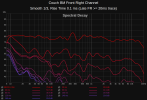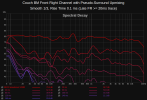A lot of you are way deeper down the rabbit hole than I, so I'm really curious what you guys have read and experienced.
Ignoring budget (obviously, or this is over before it starts), is there an optimum room/speaker configuration for music-listening? On the one hand, you can have a 2.x setup, and manage the decay times with eq and optionally, some light treatment, assuming your speakers have good directivity/off-axis response, and let your room reflections give you the sound stage and comfort. On the other hand, you can kill the room with treatment, then simulate it with extra channels and upmixing.
My amateur intuition tells me that scenario 1's benefit is that it's really easy to get working, and will make all music sound good. The downside is you'll never get that feeling of being in a concert hall - the room will always feel narrow. Plus it's perhaps not great for actual multi-channel listening or home theatre.
Scenario 2 on the other hand, seems much more difficult to get right. Upmixing will sound unnatural, especially if you're aware of the sounds you yourself are supposed to be making (but not hearing right, even with diffusion). It should work fine for music that doesn't need a wide soundstage, and should be great for spatial audio / multi-channel audio recordings, as well as home theatre, but maybe not so great for traditional 2 channel wide soundstage tracks.
Is one better than the other? Is the world slowly moving towards a more multi-channel world? Does Upmixing/multi-channel stuff work well even in a minimally/untreated room? Would love to know what people think,
Ignoring budget (obviously, or this is over before it starts), is there an optimum room/speaker configuration for music-listening? On the one hand, you can have a 2.x setup, and manage the decay times with eq and optionally, some light treatment, assuming your speakers have good directivity/off-axis response, and let your room reflections give you the sound stage and comfort. On the other hand, you can kill the room with treatment, then simulate it with extra channels and upmixing.
My amateur intuition tells me that scenario 1's benefit is that it's really easy to get working, and will make all music sound good. The downside is you'll never get that feeling of being in a concert hall - the room will always feel narrow. Plus it's perhaps not great for actual multi-channel listening or home theatre.
Scenario 2 on the other hand, seems much more difficult to get right. Upmixing will sound unnatural, especially if you're aware of the sounds you yourself are supposed to be making (but not hearing right, even with diffusion). It should work fine for music that doesn't need a wide soundstage, and should be great for spatial audio / multi-channel audio recordings, as well as home theatre, but maybe not so great for traditional 2 channel wide soundstage tracks.
Is one better than the other? Is the world slowly moving towards a more multi-channel world? Does Upmixing/multi-channel stuff work well even in a minimally/untreated room? Would love to know what people think,









